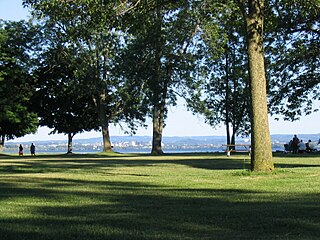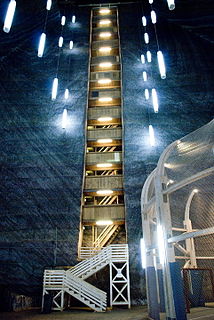 W
WThe Bochnia Salt Mine in Bochnia, Poland, is one of the oldest salt mines in the world and is the oldest commercial company in Poland. The Bochnia salt mine was established in 1248 after salt had been discovered there in the 12th and 13th centuries, and became part of the royal mining company, żupy krakowskie. In 1990 the mine ceased producing salt but remains a tourist attraction.
 W
WThe German Salt Museum in the German town of Lüneburg, on the site of the old production facilities of the Lüneburg Saltworks when it was closed in 1980. In 1991, it won the Council of Europe Museum Prize.
 W
WThe Hallein Salt Mine, also known as Salzbergwerk Dürrnberg, is an underground salt mine located in the Dürrnberg plateau above Hallein, Austria. The mine has been worked for over 7,000 years since the time of the Celtic tribes and earlier. It helped ensure nearby Salzburg would become a powerful trading community. Since World War I, it has served as a mining museum, known for its long wooden slides between levels.
 W
WThe Technical Hallors and Saline Museum was founded in the buildings of the former Royal Prussian Saline, Halle upon Saale in 1967. Hallors had been members of a brotherhood of salt producers.
 W
WThe Khewra Salt Mine is in Khewra, north of Pind Dadan Khan, an administrative subdivision of Jhelum District, Punjab Region, Pakistan. The mine is in the Salt Range, Potohar plateau, which rises from the Indo-Gangetic Plain, and is the second largest in the world.
 W
WThe Lion Salt Works is the last remaining open pan salt works in Marston, near Northwich, Cheshire, England. It closed as a work in 1986 and is now preserved as a museum.
 W
WNemocón is a municipality and town of Colombia in the Central Savanna Province, part of the department of Cundinamarca. Nemocón, famous for its salt mine, was an important village in the Muisca Confederation, the country in the central Colombian Andes before the arrival of the Spanish. The municipality is situated in the northern part of the Bogotá savanna, part of the Altiplano Cundiboyacense with its urban centre at an altitude of 2,585 metres (8,481 ft) and 65 kilometres (40 mi) from the capital Bogotá. Nemocón is the northeasternmost municipality of the Metropolitan Area of Bogotá and the Bogotá River originates close to Nemocón. The median temperature of Nemocón is 12.8 °C. The municipality borders Tausa in the north, Suesca and Gachancipá in the east, Tocancipá and Zipaquirá in the south and in the west the rivers Checua and Neusa and the municipality of Cogua.
 W
WOnondaga Lake Park is a 7.5 mile linear greenway located on the shores of Onondaga Lake, immediately west of Syracuse, New York. Most of the park lies in Liverpool.
 W
WRiserva naturale orientata Saline di Trapani e Paceco is an Italian nature reserve in the Province of Trapani between the municipalities of Trapani and Paceco on the west coast of Sicily. It was founded in 1995 and in the framework of the Ramsar Convention entrusted to WWF Italy. Its area of 987 hectares consists of two zones. Besides remarkable Mediterranean flora and fauna, there is a saline work museum in an old salt mill.
 W
WThe Saline Royale is a historical building at Arc-et-Senans in the department of Doubs, eastern France. It is next to the Forest of Chaux and about 35 kilometers from Besançon. The architect was Claude-Nicolas Ledoux (1736–1806), a prominent Parisian architect of the time. The work is an important example of an early Enlightenment project in which the architect based his design on a philosophy that favored arranging buildings according to a rational geometry and a hierarchical relation between the parts of the project.
 W
WSalina Turda is a salt mine in the Durgău-Valea Sărată area of Turda, the second largest city in Cluj County, northwest Romania. Opened for tourists in 1992, the Salina Turda mine was visited by about 618,000 Romanian and foreign tourists in 2017.
 W
WThe Salt Cathedral of Zipaquirá is an underground Roman Catholic church built within the tunnels of a salt mine 200 metres (660 ft) underground in a halite mountain near the city of Zipaquirá, in Cundinamarca, Colombia. It is a tourist destination and place of pilgrimage in the country. The temple at the bottom has three sections, representing the birth, life, and death of Jesus. The icons, ornaments and architectural details are hand carved in the halite rock. Some marble sculptures are included. The cathedral is considered one of the most notable achievements of Colombian architecture, being described as a "Jewel of Modern Architecture". The cathedral represents a valuable cultural, environmental and religious patrimony for the Colombian people.
 W
WThe Salt Museum in Pomorie is a specialized outdoor museum – visitors may see both the museum building and the 20 decares of salt-pans adjacent to the museum, where salt is still being produced. The museum showcases the ancient Anchialos method for salt production and in particular sea salt. It is dedicated to the production of salt through solar evaporation of seawater. This is the only salt museum in Southeast Europe.
 W
WStrataca is a salt mine museum in Hutchinson, Kansas, United States. It was previously known as the Kansas Underground Salt Museum. The museum is built within one of the world's largest deposits of rock salt and provides the opportunity to go 650 feet (200 m) beneath the Earth’s surface. It is a unique destination attraction for exploring an environment carved from salt deposits formed 275 million years ago. The museum is located in the Hutchinson Salt Company mine which began operation in 1923 as Carey Salt Company. There are 14 other salt mines in the United States, but none of them are accessible to tourists.
 W
WThe Taiwan Salt Museum is a museum about salt in Cigu District, Tainan, Taiwan.
 W
WThe Weaver Hall Museum and Workhouse, Northwich, Cheshire, records the social, cultural and industrial history of west Cheshire. It was formerly known as the Salt Museum, reflecting its early focus on the history of salt extraction, a local industry dating back to Roman times. The museum was renamed Weaver Hall Museum and Workhouse in 2010 as its remit now extends to cover the broader history of the area and also the history of the building itself as a former workhouse.
 W
WThe Wieliczka Salt Mine, in the town of Wieliczka, southern Poland, lies within the Kraków metropolitan area.
 W
WThe Zigong Salt History Museum is a museum in Zigong, Sichuan Province, Southwest China. It is housed in the Xiqin Guildhall, originally built in 1736-1752 by salt merchants from Shaanxi. This was during the reign of the Qianlong Emperor of the Qing dynasty. The building is a Major Historical and Cultural Site of China. The current museum was due to the urging of Deng Xiaoping and completed in 1959.
 W
WŻupy krakowskie was a Polish salt mining company which operated continuously from its inception in the 13th century to the late 20th century. It managed salt mines and salt works in two neighboring towns, Wieliczka Salt Mine in Wieliczka and Bochnia Salt Mine in Bochnia, as well as river salt ports on Vistula and, only in the 17th century, a salt work in Dobiegniewo. The company was created circa 1290 by the Polish Crown, thus giving birth to the largest industrial centre in Europe until the 18th century, according to UNESCO, both in terms of the number of employees and its production volumes.